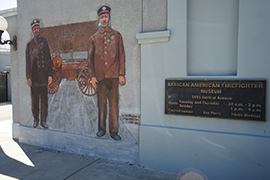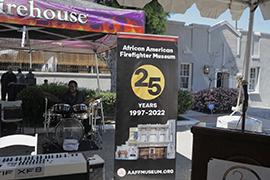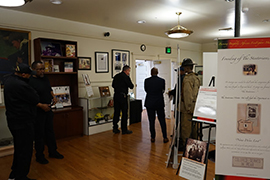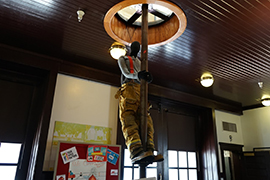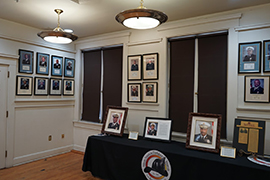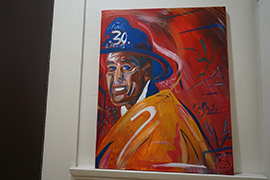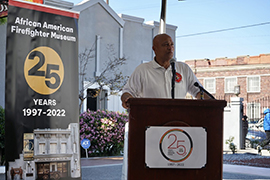- Slug: BC-CNS-Black Firefighters,550.
- 10 photos, audio story available (thumbnails, captions below).
By Ayana Hamilton
Cronkite News
LOS ANGELES – They fought fires with courage and distinction, only to be segregated within their own department.
And though that era ended long ago, the fight for equality is far from over.
They are Los Angeles’ Black firefighters, and the museum established in their honor just commemorated its 25th anniversary.
The location of the African American Firefighter Museum couldn’t be more appropriate: the city’s old Station 30, one of two segregated firehouses in Los Angeles between 1924 and 1955.
As if segregation wasn’t bad enough, when Black firefighters were eventually transferred to stations where they served with white firefighters, they were treated as outcasts. They were forced to eat alone with their own utensils and became the target of cruel pranks, according to the museum’s official history.
Discrimination has repeatedly cropped up as an issue in the past few years. In 2021, for instance, leaders of the Black and Latino firefighters in the Los Angeles Fire Department called for a federal investigation into racial bias.
The city named a Black fire chief in 2009, and flashing forward to today, the department now has hundreds of Black firefighters. It created a Diversity, Equity, and Inclusion Bureau last year.
Yet to those who remember when their ranks were far smaller, the goals remain – and not just for the city’s fire department.
Daryl Osby, the former chief of the Los Angeles County Fire Department and the first African American to hold that position, agrees that the struggle still continues because of the barriers in place.
Osby said at the event marking the museum’s 25th anniversary that African Americans lag in statistics on living conditions, economics, health, and housing.
The museum’s first president and a founding board member, Michelle Banks, is passionate about rounding up donations and volunteers to keep the retired firehouse up and running.
“The mission and purpose of the museum is to collect, conserve, and share the history of Black firefighters through collaboration,” Banks said.
Using the stories of the Black men who integrated the LAFD shows how individual and collective action can advance society.
The museum aims to promote diversity and stand up against inequality, whether it is race or gender. “While great strides have been made, inequality is still present,” county Fire Capt. Brent Burton said. He wants to continue spreading the legacy and impact Black firefighters made in a segregated world.
At the celebration, Burton told the audience that the museum has 130 years of Black firefighter history. And it wants more, not just with Blacks but women as well.
“We want more African American females. We want more females because diversity is our strength. And without diversity, we will not be strong enough to continue on what we’re doing today,” said Los Angeles Fire Inspector Gerald Durant.
LA County Fire Department Chief Anthony Marrone recognized the Black firefighters who paved the way and reflected on the need for more diverse departments. Marrone said he believes fire departments must ensure an equitable and welcoming workplace, free of discrimination, and we must all advocate for diversity.
“The fire service should represent all walks of life with members from diverse backgrounds, each sharing their own stories of what inspired them to be proud protectors of life and property on our watch,” Marrone said.
For more stories from Cronkite News, visit cronkitenews.azpbs.org.
^__=
The African American Firefighter Museum is housed in what was the Los Angeles Fire Department’s Station 30, one of two segregated firehouses in the department between 1924 and 1955. (Photo by Ayana Hamilton/Cronkite News)
The ceremony marking the museum’s 25th anniversary opened with a prayer and a live arrangement of what’s been called the Black national anthem, “Lift Every Voice and Sing.” (Photo by Ayana Hamilton/Cronkite News)
The museum gallery on the second floor includes artifacts and other memorabilia of African American firefighters from around the county. (Photo by Ayana Hamilton/Cronkite News)
Officials of the African American Firefighter Museum say its mission is “to collect, conserve, and share the history of Black firefighters through collaboration.” (Photo by Ayana Hamilton/Cronkite News)
The African American Firefighter Museum opened its doors in 1997, and it stands as the first museum dedicated to Black firefighters in the United States. (Photo by Ayana Hamilton/Cronkite News)
Even after LA firehouses were integrated, Black firefighters were often treated as outcast by white crews, forced to eat alone and targeted for cruel pranks. (Photo by Ayana Hamilton/Cronkite News)
Black firefighters formed a group in the 1950s, the Stentorians, that is still active today, helping firefighters battle racism and sexism within the department. (Photo by Ayana Hamilton/Cronkite News)
Hundreds of Black firefighters now work for the LA Fire Department, and Black firefighters have been named chief in both the LA and Los Angeles County fire departments since 2009. (Photo by Ayana Hamilton/Cronkite News)
The first Black firefighter began working for the LA Fire Department in the late 19th century, but would be another half-century before the department was integrated. (Photo by Ayana Hamilton/Cronkite News)
Los Angeles Fire Inspector Gerald Durant echoed many speakers at the museum event, when he noted that while Black firefighters have made gains, there is still much to be done or achieve a truly diverse force. (Photo by Ayana Hamilton/Cronkite News)
